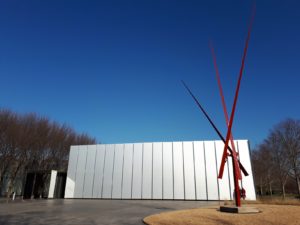 Yesterday I had a great day at North Carolina Museum of Art having a tour around the Frida Kahlo exhibition. It was an event organised by the North Carolina Fulbright Chapter (the folks who also organised the Trolley Bus tour of Raleigh). I also had a Mexican meal out with my house mates. It was a great last day out before I fly home today.
Yesterday I had a great day at North Carolina Museum of Art having a tour around the Frida Kahlo exhibition. It was an event organised by the North Carolina Fulbright Chapter (the folks who also organised the Trolley Bus tour of Raleigh). I also had a Mexican meal out with my house mates. It was a great last day out before I fly home today.

I’ll be home for a few weeks that will involve some days at the office, a good number of Christmas parties and lots of catching up with family and friends. It seems like a good time to take stock of how things have been going so far. I feel as if I’ve been working and playing hard. My research plans are nearly ready to apply for IRB approval, I’ve been putting a lot of time into planning the 2 courses I’ll be teaching in the January and Spring Semesters, I’ve been attending quite a number of strategic planning committees and events, and I’ve been making progress on my book manuscript. All of which is good progress.
Perhaps one of the things I’m most pleased with is that I feel very settled. It’s hard to make progress with work if you feel like you are still orientating to a new country, home and work settings. I am also delighted with how I have managed to get to know a large number of faculty, staff and students across campus in a short period of time. I take great pride in introducing faculty and staff to one another who I know, but who don’t know each other!
So what have I liked most about living in the USA so far?
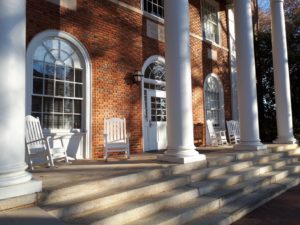
I have been enjoying sharing a house with two lovely house mates, who have made it very easy to settle into our cosy house. I have appreciated the milder weather so far, and that fall lasts longer than the 3 weeks it usually lasts in Scotland before a big storm takes away the final leaves. I’ve also appreciated 2 hours more daylight each day in the November and December.

I have enjoyed the excitement of going around a supermarket in another country (it takes me longer to do my shopping though!). I have loved the opportunity to start to get to know different parts of this vast country through the travel I’ve been fortunate to do through my work. I’m loving getting to know the names of birds in the garden, which I’ve never seen before. I particularly love the cardinals that visit. I’ve really appreciated the beautiful campus at Elon, which is simply beautiful to walk around. I’ve also enjoyed the beauty of the trees during the fall. I like campus coffee each week at Elon where everyone gets together for coffee one morning, usually outside. Who doesn’t like rocking chairs on the porch? US school buses are quite cool. I have to confess that I fear I may be addicted to pimento cheese dip! I’ve really noticed and appreciated greater racial diversity at work – and some would say that Elon is not actually that diverse. I’ve also appreciated the warmth and genuine random acts of kindness from people I’m just getting to know (an unexpected gift of a scarf; an offer of a lift to the airport; the loan of a suitcase; a bowl of homemade soup; an engraved padlock; kind words; invitations into homes; lunches; and so much more). And I’ve really enjoyed working closely with, getting to know better, and stimulating conversations about teaching and research with, a range of people on campus, but particularly folks from the Center for the Advancement of Teaching and Learning, and the Center for Engaged Learning.
Some of the newer or more challenging things I’ve faced include…
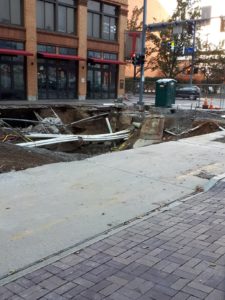
Realising there was a sinkhole that opened up a couple of weeks before I visited Pittsburgh, just outside the convention center where we were having our conference. It was big enough to swallow a bus so that was a bit scary! Seeing how quickly I have become dependent on a car to get around because public transport isn’t great or doesn’t exist to go to where I want to go, and there are either no sidewalks or fewer sidewalks in some areas that make it more tricky to walk. The challenge of buying a small carton of milk or eggs – some things are just super-sized!
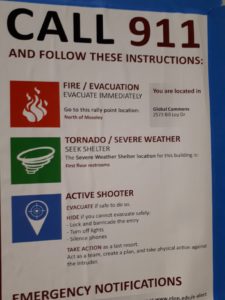
Speaking a new language that means different things when it talks about pants, biscuits, trunks and flasks! There have been some signs that I have needed to pay more attention to because they differ from signs back home. I am driven a bit bonkers by the obsession with leaf blowing on campus – it’s not just Elon, but I saw it at Bryn Mawr too. Lots of hours are spent by maintenance staff blowing leaves off paths and off the grass and then sucking them up to remove them. The problem is that the leaf blowers are usually gas powered so are totally
 environmentally dreadful and anywhere where they are sucking up leaves they are also sucking up the insects 🙁 I presume they are worried about people slipping on wet leaves… Driving on the right hand side of the road was initially quite disorienting, but I’ve adjusted quite well (I may limit how much I drive while I’m home, or I’ll need to readjust again!). Butter comes in sticks (now I know why some recipes I’ve seen refer to taking a stick of butter… and recipes are in cups/oz, ovens use fahrenheit. I also cease to be amazed at some of the more questionable ‘food’ items which include string cheese and souse (??). Because of their reliance on cars there are also a lot of drive throughs – cash points as well as food and drink options. But I was a little surprised that there is a drive thru Nativity scene nearby! I think all of these adjustments are good for me to expand my horizons. I look forward to being back in North Carolina at the end of December.
environmentally dreadful and anywhere where they are sucking up leaves they are also sucking up the insects 🙁 I presume they are worried about people slipping on wet leaves… Driving on the right hand side of the road was initially quite disorienting, but I’ve adjusted quite well (I may limit how much I drive while I’m home, or I’ll need to readjust again!). Butter comes in sticks (now I know why some recipes I’ve seen refer to taking a stick of butter… and recipes are in cups/oz, ovens use fahrenheit. I also cease to be amazed at some of the more questionable ‘food’ items which include string cheese and souse (??). Because of their reliance on cars there are also a lot of drive throughs – cash points as well as food and drink options. But I was a little surprised that there is a drive thru Nativity scene nearby! I think all of these adjustments are good for me to expand my horizons. I look forward to being back in North Carolina at the end of December.
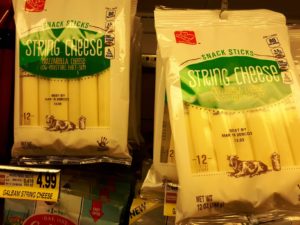
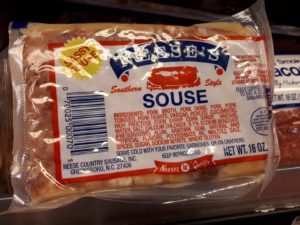


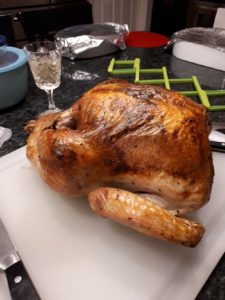
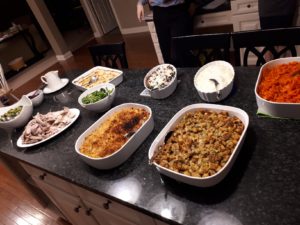





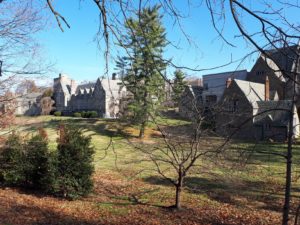
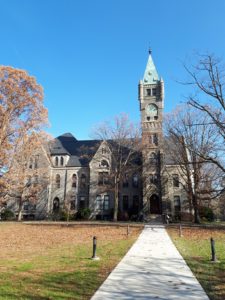
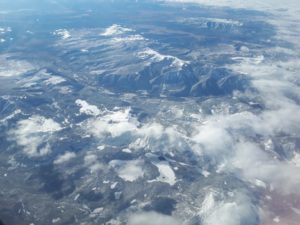 A couple of weeks ago I travelled to Salt Lake City in Utah. Salt Lake City was established by the Mormons (or Church of Jesus Christ of the Latter Day Saints) in 1847 when their leader, Brigham Young, led many Mormons away from persecution in Ohio, Missouri and Illinois, westwards on an arduous journey towards Utah. Today Salt Lake City is 50% Mormon.
A couple of weeks ago I travelled to Salt Lake City in Utah. Salt Lake City was established by the Mormons (or Church of Jesus Christ of the Latter Day Saints) in 1847 when their leader, Brigham Young, led many Mormons away from persecution in Ohio, Missouri and Illinois, westwards on an arduous journey towards Utah. Today Salt Lake City is 50% Mormon.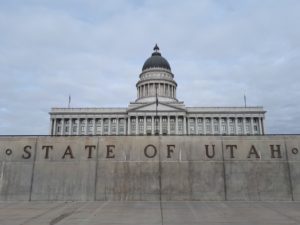
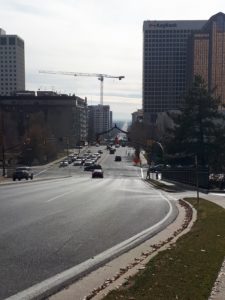
 Jon Krakauer is clear that his book was not received well by the Mormon church – and it’s easy to see why. Krakauer’s book tends to focus on some of the violent episodes in the history of the church and on the minority fundamentalist groups that have broken away from the mainstream church at different stages. Salt Lake City is 50% Mormon.
Jon Krakauer is clear that his book was not received well by the Mormon church – and it’s easy to see why. Krakauer’s book tends to focus on some of the violent episodes in the history of the church and on the minority fundamentalist groups that have broken away from the mainstream church at different stages. Salt Lake City is 50% Mormon.
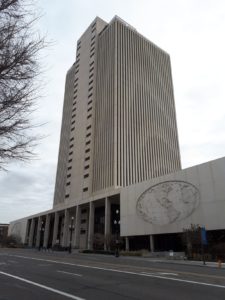


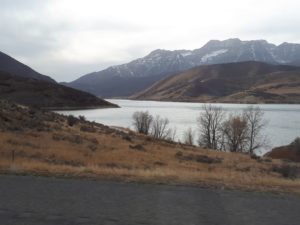
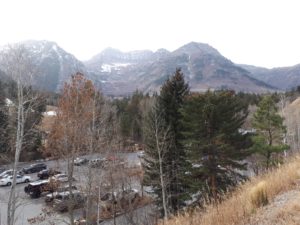


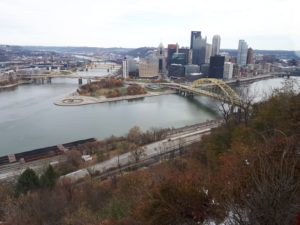 I have been in Pittsburgh for 5 days for the POD conference. Sometimes at conferences you don’t get a chance to see much of a city, but I managed to fly in slightly early and booked an extra night at the end of the trip to enable me to explore a bit more. Pittsburgh became a key settlement for a number of reasons, but the most important ones are that it has a rich seam of coal nearby and it is at the confluence of 3 rivers – the Allegheny River and the Monongahela River meet to become the Ohio River. You can compare the picture I took with the
I have been in Pittsburgh for 5 days for the POD conference. Sometimes at conferences you don’t get a chance to see much of a city, but I managed to fly in slightly early and booked an extra night at the end of the trip to enable me to explore a bit more. Pittsburgh became a key settlement for a number of reasons, but the most important ones are that it has a rich seam of coal nearby and it is at the confluence of 3 rivers – the Allegheny River and the Monongahela River meet to become the Ohio River. You can compare the picture I took with the 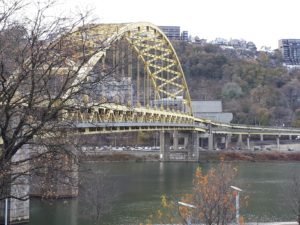
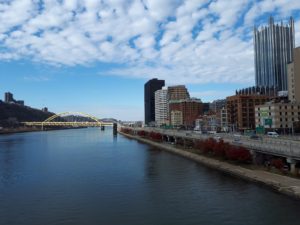 You get great views from opposite Point Park by taking the Duquesne Incline, a funicular on Mount Washington, the steep outcrop of rock opposite downtown Pittsburgh. I went for a lovely walk across Fort Pitt bridge and up the Duquesne Incline and then walked along the top of the escarpment and came back on the Monongahela Incline, another funicular that then enables you to return to downtown by crossing over the Smithfield Street bridge (designed by John A Roebling, who is also famous for designing the Brooklyn Bridge and a large scale cannon!).
You get great views from opposite Point Park by taking the Duquesne Incline, a funicular on Mount Washington, the steep outcrop of rock opposite downtown Pittsburgh. I went for a lovely walk across Fort Pitt bridge and up the Duquesne Incline and then walked along the top of the escarpment and came back on the Monongahela Incline, another funicular that then enables you to return to downtown by crossing over the Smithfield Street bridge (designed by John A Roebling, who is also famous for designing the Brooklyn Bridge and a large scale cannon!).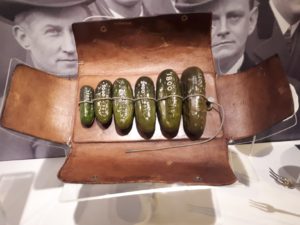
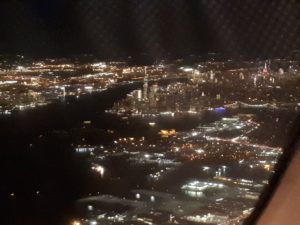 On Wednesday I flew via New York City (sorry for the slightly hazy ‘through the plane window’ picture of NYC at night), to Pittsburgh, Pennslyvania, for the POD Conference. This is a conference I’ve always been keen to attend – it’s one of the main conferences for US academic developers – similar to the Staff and Educational Development Association (SEDA) in the UK, and both POD and SEDA are members of the International Consortium for Educational Development (ICED) which has a conference every 2 years. POD is big, and this year they reached the heady heights of 1200 delegates. It was incredibly refreshing to only know a handful of people at POD. At many conferences it’s wonderful to catch up with colleagues I know, but there is something exciting in meeting new people and hearing about new practices in universities across the US. I’ll mention a few highlights.
On Wednesday I flew via New York City (sorry for the slightly hazy ‘through the plane window’ picture of NYC at night), to Pittsburgh, Pennslyvania, for the POD Conference. This is a conference I’ve always been keen to attend – it’s one of the main conferences for US academic developers – similar to the Staff and Educational Development Association (SEDA) in the UK, and both POD and SEDA are members of the International Consortium for Educational Development (ICED) which has a conference every 2 years. POD is big, and this year they reached the heady heights of 1200 delegates. It was incredibly refreshing to only know a handful of people at POD. At many conferences it’s wonderful to catch up with colleagues I know, but there is something exciting in meeting new people and hearing about new practices in universities across the US. I’ll mention a few highlights.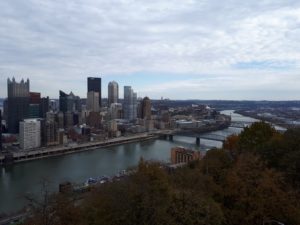
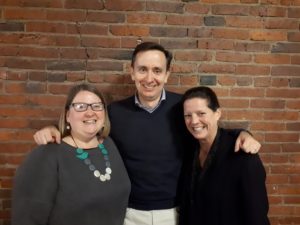

 Last weekend I was invited by President Connie Book and the Global Education Center at Elon to an early Thanksgiving dinner for international students and scholars. The event was a great way for US colleagues to be able to explain why Thanksgiving is celebrated to many people for whom this celebration is not familiar. Normally celebrated on the fourth Thursday of November, this particular dinner party was early, but this worked well for me as I was pleased to be able to attend – I suspect otherwise my US travel would have meant I’d have missed it.
Last weekend I was invited by President Connie Book and the Global Education Center at Elon to an early Thanksgiving dinner for international students and scholars. The event was a great way for US colleagues to be able to explain why Thanksgiving is celebrated to many people for whom this celebration is not familiar. Normally celebrated on the fourth Thursday of November, this particular dinner party was early, but this worked well for me as I was pleased to be able to attend – I suspect otherwise my US travel would have meant I’d have missed it. There are lots of variations in the accounts of the first Thanksgiving, but essentially early settlers in Virginia had a good harvest and apparently shared this harvest in a feast with native Americans. There are many critics of this version of events, but modern day Thanksgiving seems to emphasise family getting together to share a turkey dinner and pumpkin pie and articulating what they are thankful for. The picture shows me with my housemates Kristen and Babu at the Elon international thanksgiving dinner. We will see if there are any variations on this explanation of thanksgiving, when I go to Peter and Sara Felten’s for the real thing in a fortnight (…a turn of phrase I have just learned is considered British English in the USA – they don’t use fortnight or fortnightly).
There are lots of variations in the accounts of the first Thanksgiving, but essentially early settlers in Virginia had a good harvest and apparently shared this harvest in a feast with native Americans. There are many critics of this version of events, but modern day Thanksgiving seems to emphasise family getting together to share a turkey dinner and pumpkin pie and articulating what they are thankful for. The picture shows me with my housemates Kristen and Babu at the Elon international thanksgiving dinner. We will see if there are any variations on this explanation of thanksgiving, when I go to Peter and Sara Felten’s for the real thing in a fortnight (…a turn of phrase I have just learned is considered British English in the USA – they don’t use fortnight or fortnightly).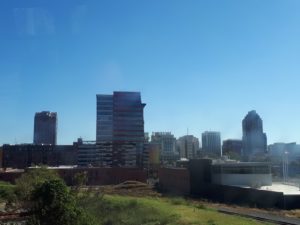 Last weekend I was invited by the North Carolina Fulbright Chapter (a local organisation of ex Fulbrighters and friends of Fulbrighters who put on events for current, ex, and friends of, Fulbrighters!) to have an historical Trolley bus tour of Raleigh. Charlotte may be the largest city in the state but Raleigh is officially the state capital.
Last weekend I was invited by the North Carolina Fulbright Chapter (a local organisation of ex Fulbrighters and friends of Fulbrighters who put on events for current, ex, and friends of, Fulbrighters!) to have an historical Trolley bus tour of Raleigh. Charlotte may be the largest city in the state but Raleigh is officially the state capital.
 Downtown Raleigh is mainly museums and businesses. There are almost no shops, with the large stores all in out-of-town shopping centres. One of the parts of the tour I found fascinating was that in part of the pavement in Raleigh, the bricks used were made by prisoners in the late 1800s.
Downtown Raleigh is mainly museums and businesses. There are almost no shops, with the large stores all in out-of-town shopping centres. One of the parts of the tour I found fascinating was that in part of the pavement in Raleigh, the bricks used were made by prisoners in the late 1800s.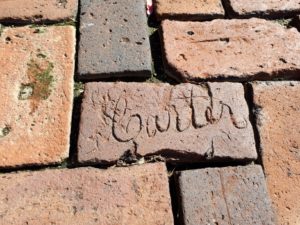 The prisoners were required to write their names on the top brick of the pile of bricks they had made each day so that their productivity could be measured. What this means is that some of the bricks in the pavement have prisoners names on them. Our historical tour introduced us to many of the key buildings and sights of Raleigh.
The prisoners were required to write their names on the top brick of the pile of bricks they had made each day so that their productivity could be measured. What this means is that some of the bricks in the pavement have prisoners names on them. Our historical tour introduced us to many of the key buildings and sights of Raleigh.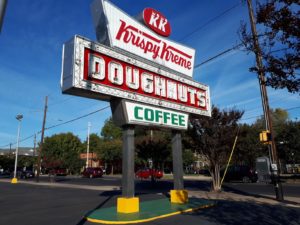
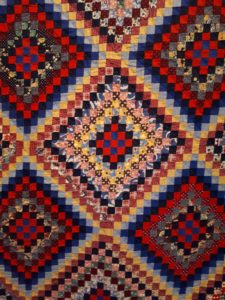
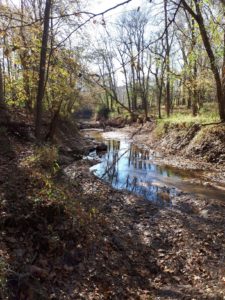
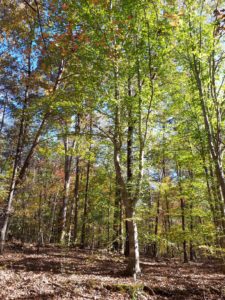
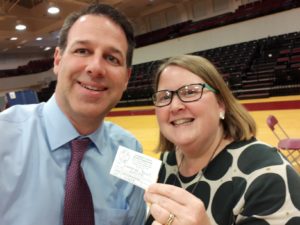


 I am also planning for the second course I’ll be teaching, which is one I’ll be running on my own from the start of February through until mid March. This course is entitled ‘Co-Creation of Learning Environments: Partnerships in and Beyond the Classroom’, and will draw on quite a bit of my own research. It’s being offered to both first and second year students on the Masters programme and it looks like I should have 8-10 students – a lovely number to teach! It’s actually quite encouraging to have this number of students sign up because this is additional credit for these students over and above the required credits they need to complete. I am delighted these students are motivated to do the course, and I’m planning a lot of opportunities for co-creation. So I’m excited to meet the students and see how the course will go.
I am also planning for the second course I’ll be teaching, which is one I’ll be running on my own from the start of February through until mid March. This course is entitled ‘Co-Creation of Learning Environments: Partnerships in and Beyond the Classroom’, and will draw on quite a bit of my own research. It’s being offered to both first and second year students on the Masters programme and it looks like I should have 8-10 students – a lovely number to teach! It’s actually quite encouraging to have this number of students sign up because this is additional credit for these students over and above the required credits they need to complete. I am delighted these students are motivated to do the course, and I’m planning a lot of opportunities for co-creation. So I’m excited to meet the students and see how the course will go.